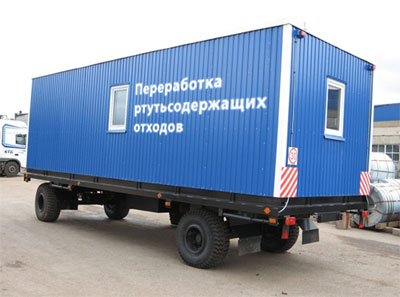A new approach is proposed to solve the problem of hazardous waste - to transport non-mercury-containing waste to the processing unit, but to the waste.
One of the most pressing environmental problems is the contamination of the environment with mercury and its compounds.
Wastes containing mercury are classified as hazard class I wastes. Their handling, long-term storage and transportation pose a danger of destruction of mercury-containing lamps and devices and pollution of territories by mercury.
As a rule, the processing of mercury-containing waste in the regions is organized by private enterprises using various stationary installations. The territorial location of such enterprises requires the transportation of waste lamps and devices with mercury filling over long distances, which is associated with certain environmental risks and material costs. A set of documentation for the creation of a mercury-containing waste processing mobile section (MCWPMS) has been developed to solve the problem.
STRUCTURAL SOLUTIONS OF THE MERCURY-CONTAINING WASTE PROCESSING SECTION (MCWPMS)
Structural solutions taken in the implementation of the technical design, meet the SP 4607-88 requirements.
A standard 1AAA container is used according to GOST R 53350-2009 as a block divided into premises with the placement of the main and auxiliary equipment in them when creating a MCWPMS.
One of the existing and positively proven stationary demercurization unit for mercury-containing lamps, URL-2M, has been used at the MCWPMS.
MCWPMS is divided into premises:
- workroom (designed for undressing, dressing and storing personal clothes of the staff. "Clean locker room" is equipped with cabinets and a hanger for storing outer clothing);
- sanitary facilities;
- room for dirty clothes - "dirty dressing room" (designed for dressing, undressing and storing the overalls of the staff and their demercurization in the fume hoods). Here is a shower for the staff;
- URL-2m unit premises (designed for the processing of mercury-containing waste). The room has hinged external sealed doors intended for loading faulty mercury-containing fluorescent lamps and devices with mercury filling and mercury-contaminated auxiliary materials, as well as for unloading of the container with recycled cullet and plinths;
- room for the placement of auxiliary equipment to ensure the unit work performance.

ENGINEERING SYSTEMS AND EQUIPMENT
Structurally the MCWPMS is a container inside which the following engineering systems and equipment are located:
- URL-2m thermal demercurization unit;
- power supply network;
- lighting network;
- ventilation and heating system;
- water supply and sewage system;
- URL-2m unit cooling system;
- security-fire signal system;
- telephone system;
- access control system
- gas analysis system;
- process control and automation devices;
- furniture and office equipment.
PROCESS SOLUTIONS
The safe operation procedure and conditions, execution of technological processes and work at the MCWPMS meet the PB 11-550-03 requirements "Safety rules for mercury production".
Delivery of fluorescent lamps is carried out in the lamp manufacturer's packaging.
Defective mercury-containing fluorescent lamps and devices with mercury filling, as well as mercury-contaminated auxiliary materials pass through the swing doors of the URL-2m unit room. The cullet with the plinths is unloaded into the container which is carried out through the swing doors after demercurization. Unloading of the secondary mercury from the URL-2m unit metallic mercury collection unit is carried out in a steel cylinder with a sealed cover above the tray, pre-installed under a metal mercury collector. The container with secondary mercury is stored in the URL-2m unit room in a safe under the exhaust ventilation. When leaving the URL-2m unit room and entering the "dirty dressing room", the personnel wash the work shoes in a pallet with demercurizer solutions, leave overalls in the fume hood, perform the sanitary treatment of the skin in the shower room and go into the "clean locker room".
WASTE HANDLING
The handling of waste generated in the process of demercurization depends on the particular enterprise where the MCWPMS will be used:
- secondary mercury, corresponding to group 1 according to GOST R 52105-2003 is sent to the specialized enterprises for further processing for obtaining marketable mercury metal;
- socles of linear and compact fluorescent lamps, mercury arc lamp (MAL) burners are separated from the cullet and recycled or, without separation from cullet, are transported to the landfill of domestic waste;
- socles in fluorescent lamps are electronic ballast and are to be sent to the specialized organizations for the separation of non-ferrous, precious metals and alloys, and further disposal;
cullet is recyclable or may be transported to the landfill of domestic waste together with the socles.
MEASURES PREVENTING THE ENVIRONMENT POLLUTION
When MCWPMS is used by a factor that may have a negative impact on the environment, there is the probability of release of vapors and mercury aerosols into the atmosphere. To prevent from this, air before its discharge from the "dirty" zone is cleaned by the FP-300 filter. Demercurization measures are envisaged in accordance with SP 4607-88 if mercury or used sorbent spills on the floor. Overalls with mercury spills on it shall be demercurized in the URL-2M unit or processed in a special laundry facility. The collection of contaminated wiping cloth, overalls, personal protective equipment is made in polyethylene bags, which are then placed in a special container installed in the URL-2M room.
UKR-1MC gas analyzer with attachments monitors:
- content of residual mercury in the cullet after processing;
- mercury vapors in the air of the working area during work execution;
- air discharge from the exhaust pipe from the "dirty" premises.
Secondary mercury shall be stored in a steel cylinder with a screwed steel stopper in the safe of the URL-2M room. Overalls storage is provided in a fume hood.
OPERATING CHARACTERISTICS OF THE MOBILE MERCURY-CONTAINING WASTE PROCESSING SECTION
MCWPMS allows to carry out the demercurization of:
- fluorescent lamps, as well as MAL high-pressure mercury lamp burners;
- out-of-order devices with mercury filling (thermometers, ignitrons, etc.);
- contaminated with mercury soils and plaster;
- overalls contaminated with mercury.
The unit can perform the regeneration of:
- non-impregnated activated carbon (coal contained in FP-300 filters);
- impregnated activated carbon (coal impregnated with a chemical substance to activate chemisorption processes, for example, with MVCA (mercury vapor chemical absorbent).
MCWPMS operating conditions are: open area, air temperature – from minus 30 to plus 30°C. Resource requirements: electric power (alternating three-phase current, voltage – 380V, 50Hz, maximum power consumption – 30.8kW).
FINDINGS
The solution to the waste management problem is not only to reduce their formation, but also to improve the technologies for their neutralization and disposal. The MCWPMS project complies with the requirements of the regulatory documentation for mercury handling, it provides for minimizing the risks of mercury releases. The use of a mobile unit makes it possible to exclude the transportation of mercury-containing wastes from industrial enterprises to the specialized enterprises and, thereby, to reduce the disposal costs. Compliance with the sanitary legislation requirements is confirmed by a positive sanitary and epidemiological conclusion.
